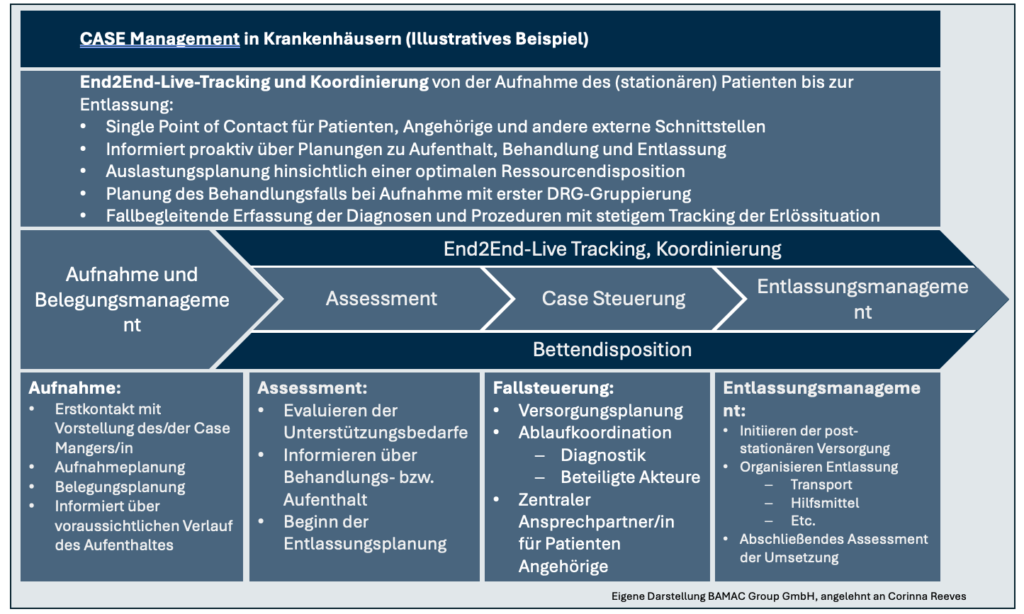How to reduce your costs with digital case management!
In many areas, we have been familiar with it for years – digitalized processes that we can initiate with just a few clicks. The good news is that we can also establish this simplification of our everyday lives in the healthcare system. More precisely, in your care facility! In this article, we show you how you can easily save costs with digital case management.
Time is money – after talking to many practitioners in the healthcare sector, two things in particular have become clear to us. There is not only a lack of resources, but also a lack of effectiveness and efficiency in daily processes. In this article, we would therefore like to show you how you can increase both the efficiency and effectiveness of all processes in your care facility by establishing digital case management, thereby reducing costs.
The healthcare sector is facing a number of challenges. Both internal and external factors are making the core business of hospitals and other care facilities more difficult. Before we show you how digital case management helps to reduce costs, we will first look at the internal challenges that cause unnecessary costs.
Internal cost drivers
In our discussions with practitioners and managers in the healthcare sector, we were able to identify the following cost drivers. This is because the processes in day-to-day work are often
- analog
- inefficient
- not interconnected
- prone to errors
- not measurable
- thereby heavily optimized
- isolated or not linked end-to-end from the patient’s admission to discharge.
Consequences of internal cost drivers
The result is inefficient and ineffective processes that create the proverbial duplicate paths. You probably know it from your day-to-day work: in many places, communication and coordination between the individual departments gets stuck, resulting in waiting times for patients and duplicated or even missed examinations. This is often due to the fact that different IT systems are used within a facility that are not networked with each other. The result is often that every department has to re-record all patient data. This costs time and complicates communication, both between professionals and between staff and patients or relatives. There is also a risk that information could be lost in the process.
External cost drivers
A selection of external factors that make daily care work increasingly challenging are:
- increasingly complex regulatory compliance and legal requirements and the associated
- ever more extensive documentation requirements,
- a growing sense of entitlement on the part of patients and relatives and
- increasing possibilities for the diagnosis and treatment of diseases.
Consequences of external cost drivers
Countering all these factors in the digital age with analog and/or non-networked IT systems leads to avoidable extra work and unnecessary costs. This also makes it more difficult to evaluate and optimize work processes.
The solution? Digital case management!
While we have a direct influence on internal factors and can (gradually) reduce them, with external factors we (only) have the option of choosing how we react to them. It is clear that efficient management and coordination of patient cases is essential in order to meet all these challenges effectively.
This is made possible by the consistent digitalization of organizational processes! Here is a practical case study to show how the introduction of digital case management has reduced costs.
Resource optimizationin digital case management
Digital case management in the healthcare system helps to make effective and efficient use of existing resources. Better coordination and planning can avoid duplicate examinations and unnecessary measures and reduce inpatient stays. Fast and effective patient care saves significant resources and costs without compromising the quality of treatment.
What is digital case management?
Think of digital case management as a software solution that makes it possible to manage patient cases electronically, from admission to discharge. Information on diagnoses, treatments, medication and other relevant data is centralized and stored on a digital platform. Automated workflows and integrated communication tools allow doctors, nurses and other professionals to work together seamlessly and improve patient care.
The advantages of digital case management in the healthcare sector
Digital case management offers a variety of benefits for the healthcare sector, including improved patient care through efficient case management, optimizing workflows and resource utilization, reducing errors and duplication, and promoting collaboration between different departments and professionals. We have compiled the specific advantages of digital case management for you.
Reduce your costs with digital case management
The special thing about digital case management is the role of the case manager as a mediator and coordinator between the various stakeholders. It helps to improve communication. This reduces misinformation and misunderstandings and ensures better and safer patient care.
On the other hand, process excellence and digitalization enable better coordination of patient care. Specifically, this enables a more efficient use of resources and a reduction in administrative tasks. Preventive measures can also be controlled by digital case management. As you know, these are primarily used to avoid expensive complications and, as a result, repeat hospital stays.
However, the introduction of digital case management not only reduces costs. Implementing this approach also allows for individualization in patient care, which results in greater satisfaction and increased chances of recovery.
The following diagram illustrates the process.

Digital case management in practice
If digital case management is fully implemented in a facility, then the planning of the treatment case begins as soon as the patient is admitted. In addition, diagnoses and treatments are recorded during the case so that they can be viewed and controlled by all departments of the facility in a central, digital location. When the patient is discharged, digital case management is used to plan and organize not only the day of discharge, but also post-inpatient care by the family doctor, outpatient nursing service, etc.
In summary, the introduction of digital case management represents a strategic investment for the healthcare system that can both reduce costs and improve the quality of care in the long term.
Digital case management is a pragmatic and effective method for improving quality and efficiency in your organization. With consistent digitalization, combined with the use of modern technology and adaptation to local needs, many of your current challenges can be addressed and solved. The implementation of case management is the instrument for a patient-centered and resource-efficient system that is equipped for the future.
If you are looking for a reliable partner at your side along the way, then the BAMAC GROUP is the right place for you, because we know how to manage projects and implement change. Above all, it is important to us to support our customers individually and with an end-to-end approach. If you would like to know more about this, please contact us.
Categories of this post
Further interesting posts.




